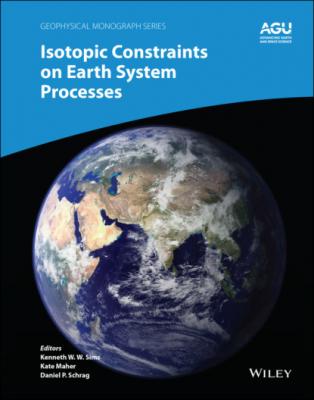Isotopic Constraints on Earth System Processes. Группа авторов
Чтение книги онлайн.
Читать онлайн книгу Isotopic Constraints on Earth System Processes - Группа авторов страница 37
 (mm to cm) in lavas ranging in composition from alkali basalt to rhyodacite. They interpreted the effects as being due to diffusive isotope fractionation during crystal growth superimposed on small equilibrium fractionation effects. With knowledge of β factors, they used the model of Watson and Müller (2009) to show how Ca isotope fractionation could be used as a measure of crystal growth rates. They inferred plagioclase growth rates of order 0.03 to 0.3 cm/yr, which is in broad agreement with other estimates of typical volcanic phenocryst growth rates. This approach can be extended to other K‐bearing minerals (e.g., K‐spar, muscovite) using K isotopes in lieu of Ca isotopes.
(mm to cm) in lavas ranging in composition from alkali basalt to rhyodacite. They interpreted the effects as being due to diffusive isotope fractionation during crystal growth superimposed on small equilibrium fractionation effects. With knowledge of β factors, they used the model of Watson and Müller (2009) to show how Ca isotope fractionation could be used as a measure of crystal growth rates. They inferred plagioclase growth rates of order 0.03 to 0.3 cm/yr, which is in broad agreement with other estimates of typical volcanic phenocryst growth rates. This approach can be extended to other K‐bearing minerals (e.g., K‐spar, muscovite) using K isotopes in lieu of Ca isotopes.
Another example is the study by Chopra et al. (2012), who used their knowledge of Mg isotope fractionation effects to evaluate the isotopic gradients at the boundaries of a pillowed mafic dike intruded into a granitic intrusion at Vinalhaven, Maine. They used the isotope effects to confirm that diffusion was responsible for the chemical gradients and estimated a diffusion timescale for cooling of the dike‐granite system. We envision extending this to other elements (Ca and K) and other sites. There are many field localities where a mafic (gabbroic) magma with 6–8% CaO and < 1% K2O has intruded a more silicic (granitic) body with 1–2% CaO and 2–5% K2O. The Ca concentration gradient is downward toward the granitic phase and the K concentration gradient is downward toward the gabbroic phase. We anticipate that the use of two or more isotopic systems, such as Ca and K, with different temperature‐dependent diffusivities could provide unique information on mixing and cooling processes in magmatic systems.
APPENDIX LINEAR VERSUS EXPONENTIAL DEPENDENCE OF ACTIVITY ON SIO2
Here we show that the model outputs and conclusions are not dependent on whether the activity is linearly or exponentially dependent on SiO2 concentration. If the activity is an exponential function of SiO2, then the equation for Ce
(2.A1)
becomes
(2.A2)
where the parameter B is functionally similar to the parameter Cf (Zhang, 1993). An exponential dependence was also adopted by Richter (1993). Fig. 2.9 compares the two approaches side by side and shows that the results and conclusions are not sensitive to this particular aspect of the Zhang model.
ACKNOWLEDGMENTS
We are grateful for constructive reviews by James Van Orman and an anonymous reviewer. The experimental work of JMW was supported primarily by the National Science Foundation under Grant Nos. EAR0838168 and EAR0608885 to DJD. Support for isotopic analysis was also provided by the Director, Office of Science, Office of Basic Energy Sciences, of the U.S. Department of Energy under Contract No. DEAC02‐05CH11231. This work was partially performed under the auspices of the U.S. Department of Energy by the University of California, Lawrence Livermore National Laboratory, under Contract Nos. W‐7405‐ Eng‐48, DE‐AC52‐07NA27344, and DE‐AC02‐05CH1123.
Figure 2.9 The 2.5 hour run modeled using a linear dependence of CaO activity on SiO2 (left panels) versus and exponential dependence on SiO2 (right panels). The inferred β factors are the same regardless of which approach is used.
REFERENCES
1 Antonelli, M., Mittal, T., McCarthy, A., Tripoli, B., Watkins, J., & DePaolo, D. (2019a). Ca isotopes record rapid crystal growth in volcanic and subvolcanic systems. Proceedings of the National Academy of Sciences, 116, 20315–20321. https://doi.org/10.1073/pnas.1908921116
2 Antonelli, M. A., Schiller, M., Schauble, E. A., Mittal, T., DePaolo, D. J., Chacko, T., et al. (2019b). Kinetic and equilibrium Ca isotope effects in high‐T rocks and minerals. Earth and Planetary Science Letters, 517, 71–82. https://doi.org/10.1016/j.epsl.2019.04.013
3 Barrat, J.‐A., Chaussidon, M., Bohn, M., Gillet, P., Göpel, C., & Lesourd, M. (2005). Lithium behavior during cooling of a dry basalt: An ion‐microprobe study of the lunar meteorite Northwest Africa 479 (NWA 479). Geochimica et Cosmochimica Acta, 69(23), 5597–5609. https://doi.org/10.1016/j.gca.2005.06.032
4 Beck, P., Chaussidon, M., Barrat, J.‐A., Gillet, P., & Bohn, M. (2006). Diffusion induced Li isotopic fractionation during the cooling of magmatic rocks: the case of pyroxene phenocrysts from nakhlite meteorites. Geochimica et Cosmochimica Acta, 70(18), 4813–4825. https://doi.org/10.1016/j.gca.2006.07.025
5 Bourg, I. C., Richter, F. M., Christensen, J. N., & Sposito, G. (2010). Isotopic mass dependence of metal cation diffusion coefficients in liquid water. Geochimica et Cosmochimica Acta, 74(8), 2249–2256. https://doi.org/10.1016/j.gca.2010.01.024
6 Chakraborty, S., Dingwell, D. B., & Rubie, D. C. (1995). Multicomponent diffusion in ternary silicate melts in the system K2O‐Al2O3‐SiO2: II. Mechanisms, systematics, and geological applications. Geochimica et Cosmochimica Acta, 59(2), 265–277. https://doi.org/10.1016/0016‐7037(94)00283‐R
7 Chen, L.‐M., Teng, F.‐Z., Song, X.‐Y., Hu, R.‐Z., Yu, S.‐Y., Zhu, D., & Kang, J. (2018). Magnesium isotopic evidence for chemical disequilibrium among cumulus minerals in layered mafic intrusion. Earth and Planetary Science Letters, 487, 74–83. https://doi.org/10.1016/j.epsl.2018.01.036
8 Chopra, R., Richter, F. M., Watson, E. B., & Scullard, C. R. (2012). Magnesium isotope fractionation by chemical diffusion in natural settings and in laboratory analogues. Geochimica et Cosmochimica Acta, 88, 1–18. https://doi.org/10.1016/j.gca.2012.03.039
9 Christensen, J. N., Qin, L., Brown, S. T., & DePaolo, D. J. (2018). Potassium and calcium isotopic fractionation by plants (soybean [Glycine max], rice [Oryza sativa], and wheat [Triticum aestivum]). ACS Earth and Space Chemistry, 2(7), 745–752. https://doi.org/10.1021/acsearthspacechem.8b00035
10 Cooper, A. R. (1968). The use and limitations of the concept of an effective binary diffusion coefficient for multi‐component diffusion. Mass Transport